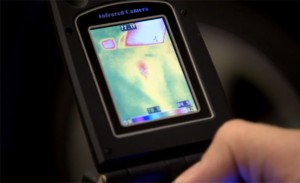The engineers at Ford Motor Company are now utilizing technology that has traditionally been used by law enforcement and our military to catch high-level criminals. They are using this technology to help them find leaks and help improve the overall interior quietness of the vehicle.
Thermal imaging cameras capture the radiation present then display it as an infrared image. The engineers then use this information to look at hot spots where the heated air escapes from the vehicle.
Ford Vs. Competition
According to data from Ford’s U.S. Global Quality Research System, the 2013 Ford Fusion earned a 67 percent approval rating for interior quietness compared to 58 percent for the 2012 Toyota Camry.*
“Ford is redefining our vehicles through many innovations – both features to improve the driving experience and fuel economy, and advanced new tools to help engineer better vehicles,” said William Dedecker, noise, vibration and harshness engineering supervisor. “We are using thermal imaging to further improve quietness so customers can enjoy the other features our vehicles offer, such as audio systems… and even the sounds of silence.”
Closing the Gap
Not only does this help Ford reduce noise and control air leaks; it helps increases heating and cooling efficiency by reducing energy loss, similar to how sealing a home prevents leaks of heated air in the winter and air conditioning in the summer.
Before thermal imaging, Ford engineers relied on sensory findings to prevent air leaks. They would fill the car with smoke, then watch for the smoke to exit from small holes. They also walked around a vehicle and would feel for air leakage. In addition, they relied on non-medical stethoscopes to try to hear air leaking from the cabin, a method they still rely on to some extent.
While successful, these approaches were not as consistent. With the use of thermal imaging, engineers can speed up development time by finding results at a faster rate.
Engineers have identified several key areas that are vulnerable to air leaks and letting noise into a vehicle, including moonroofs, window glass, door trim, trunk lids and liftgates, doors and the base of the windshield.
Check out the full Ford lineup at www.ReedHasIt.com!
Read the whole store here: http://media.ford.com/article_display.cfm?article_id=38210

